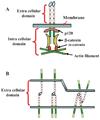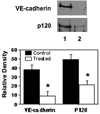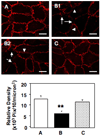Placenta-derived chymotrypsin-like protease (CLP) disturbs endothelial junctional structure in preeclampsia
- PMID: 19126871
- PMCID: PMC3065969
- DOI: 10.1177/1933719108329818
Placenta-derived chymotrypsin-like protease (CLP) disturbs endothelial junctional structure in preeclampsia
Abstract
Placenta-derived chymotrypsin-like protease may contribute to endothelial activation in preeclampsia. In this study, we determined if placenta-derived chymotrypsin-like protease could disturb endothelial junctional integrity to promote endothelial permeability in preeclampsia. Confluent endothelial cells were cocultured with placental trophoblasts or treated with preeclampsia placenta-conditioned medium. Endothelial junction protein vascular endothelial cadherin expression and distribution were examined by fluorescent staining of endothelial cells with or without depletion of chymotrypsin. The association of endothelial cell junction protein complex VE-cadherin/beta-catenin/p120 was examined by a combined immuno-precipitation and immuno-blotting assay. Our results showed that endothelial cells cocultured with preeclampsia trophoblasts or exposed to preeclampsia placental conditioned medium exhibited a discontinuous distribution and reduced expression of vascular endothelial cadherin at cell contact regions. Vascular endothelial cadherin and p120 were expressed in control endothelial cells, but reduced or lost in endothelial cells exposed to preeclampsia placental conditioned medium, suggesting that the junctional protein complex of VE-cadherin/beta-catenin/p120 was disrupted in endothelial cells exposed to preeclampsia placental conditioned medium. We also observed that removal of trophoblasts from the coculture system and depletion of the protease from the preeclampsia placental conditioned medium could restore the dysregulated endothelial junction protein expression and distribution. Chymotrypsin also induced a dose dependent increase in endothelial monolayer permeability. We conclude that chymotrypsin-like protease released by the placenta is at least one important mediator responsible for disrupting endothelial cell integrity and inducing endothelial permeability in preeclampsia.
Figures





Similar articles
-
Chymotrypsin-like protease (chymase) mediates endothelial activation by factors derived from preeclamptic placentas.Reprod Sci. 2009 Sep;16(9):905-13. doi: 10.1177/1933719109337333. Epub 2009 Jun 3. Reprod Sci. 2009. PMID: 19494363 Free PMC article.
-
PAR-2 triggers placenta-derived protease-induced altered VE-cadherin reorganization at endothelial junctions in preeclampsia.Placenta. 2012 Oct;33(10):803-9. doi: 10.1016/j.placenta.2012.06.020. Epub 2012 Jul 26. Placenta. 2012. PMID: 22840244 Free PMC article.
-
Increased neutrophil-endothelial adhesion induced by placental factors is mediated by platelet-activating factor in preeclampsia.J Soc Gynecol Investig. 1999 May-Jun;6(3):136-41. doi: 10.1016/s1071-5576(99)00004-0. J Soc Gynecol Investig. 1999. PMID: 10376269
-
Role of chymase in preeclampsia.Curr Vasc Pharmacol. 2013 Sep;11(5):606-15. doi: 10.2174/1570161111311050005. Curr Vasc Pharmacol. 2013. PMID: 24063379 Review.
-
TGFβ signalling: a nexus between inflammation, placental health and preeclampsia throughout pregnancy.Hum Reprod Update. 2024 Jul 1;30(4):442-471. doi: 10.1093/humupd/dmae007. Hum Reprod Update. 2024. PMID: 38519450 Free PMC article. Review.
Cited by
-
Focus on the Gut-Kidney Axis in Health and Disease.Front Med (Lausanne). 2021 Jan 21;7:620102. doi: 10.3389/fmed.2020.620102. eCollection 2020. Front Med (Lausanne). 2021. PMID: 33553216 Free PMC article. Review.
-
Factors derived from preeclamptic placentas perturb polarity protein PARD-3 expression and distribution in endothelial cells.Reprod Sci. 2011 Feb;18(2):164-71. doi: 10.1177/1933719110382920. Epub 2010 Oct 19. Reprod Sci. 2011. PMID: 20959641 Free PMC article.
-
Chymotrypsin-like protease (chymase) mediates endothelial activation by factors derived from preeclamptic placentas.Reprod Sci. 2009 Sep;16(9):905-13. doi: 10.1177/1933719109337333. Epub 2009 Jun 3. Reprod Sci. 2009. PMID: 19494363 Free PMC article.
-
Multifunctional Role of Chymase in Acute and Chronic Tissue Injury and Remodeling.Circ Res. 2018 Jan 19;122(2):319-336. doi: 10.1161/CIRCRESAHA.117.310978. Circ Res. 2018. PMID: 29348253 Free PMC article. Review.
-
Mast Cell Proteases and Inflammation.Drug Discov Today Dis Models. 2011 Spring;8(1):47-55. doi: 10.1016/j.ddmod.2011.06.004. Drug Discov Today Dis Models. 2011. PMID: 22125569 Free PMC article.
References
-
- Campbell DM, Campbell AJ. Evans blue disappearance rate in normal and preeclamptic pregnancy. Clin Exp Hypertens. 1983;2:163–169. - PubMed
-
- Brown MA, Zammit VC, Lowe SA. Capillary permeability and extracellular fluid volumes in pregnancy-induced hypertension. Clin Sci. 1989;77:599–604. - PubMed
-
- Svedas E, Islam KB, Nisell H, Kublickiene KR. Vascular endothelial growth factor induced functional and morphologic signs of endothelial dysfunction in isolated arteries from normal pregnant women. Am J Obstet Gynecol. 2003;188:168–176. - PubMed
-
- Wang Y, Gu Y, Granger DN, Roberts JM, Alexander JS. Endothelial junctional protein redistribution and increased monolayer permeability in HUVECs isolated during preeclampsia. Am J Obstet Gynecol. 2002;186:214–220. - PubMed
-
- Svedas E, Nisell H, Vanwijk MJ, Nikas Y, Kublickiene KR. Endothelial dysfunction in uterine circulation in preeclampsia: Can estrogens improve it? Am J Obstet Gynecol. 2002;187:1608–1616. - PubMed
Publication types
MeSH terms
Substances
Grants and funding
LinkOut - more resources
Full Text Sources
Miscellaneous

